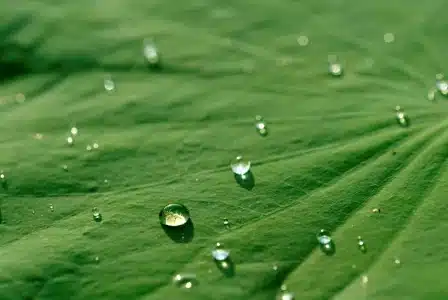Water’s Dual Impact in Spray Tanks
Water, the primary component in most spray tank mixtures, excels as a solvent (a medium for holding and transporting other chemical substances), it is cost-effective and readily available. The surface tension of water can be described as the energy or force that causes a liquid surface to resist external forces aimed at influencing the liquid’s surface behavior. Water has a high surface tension and therefore, presents challenges, particularly in its interaction with hydrophobic surfaces (surfaces that do not like water), like plant leaves. This tension results in water droplets binding strongly together, rather than spreading on surfaces that repel water. Consequently, water droplets tend to form beads on such surfaces, impacting the efficiency of spray tank applications. Addressing this limitation through modifications in the spray mixture can enhance performance on diverse leaf surfaces.
Spraying Dynamics: Understanding Water Behaviors.
In the spraying process, liquid is expelled from a container as fine droplets using pressure. This action, combined with water’s tendency to bead, can lead to various outcomes when sprayed on leaf surfaces.
- Bounce: Droplets veering off target.
- This can lead to a substantial portion of the spray mixture missing the target leaf surface.
- Shatter: Droplets breaking up upon impact.
- When sprayed, water droplets can fragment into smaller ones upon contact with a leaf surface. This fragmentation is influenced by the sprayer’s droplet size and force, as well as the distance between the sprayer and the leaf.
- Run-off: Droplets sliding off angled leaves.
- Leaves on plants are typically angled, causing larger droplets to roll off their surfaces due to their momentum.
- Adhesion: Droplets clinging to the leaf surface.
- These droplets adhere to the leaf’s surface due to the attractive force between the water molecules and the leaf.
Herbicides and water spray tank mixture: Without Adjuvants
Understanding herbicide formulation is crucial for optimizing water properties in spray mixtures, to minimize issues like bouncing and runoff, and to enhance leaf surface adhesion. Herbicides comprise active ingredients for weed control and inert ingredients like organic solvents, for dissolving and transporting the active components. Yet, many formulations lack sufficient surfactants to counteract water’s negative effects. For optimal effectiveness, herbicides in spray mixtures must have sufficient time to reach and act on their intended target site, whether these are on the surface of the leaf or inside the plant itself. Without added adjuvants, a lesser amount of the active ingredient reaches its target site, leading to ineffective weed control and inefficient resource use for weed management in various settings.

Herbicides and water spray tank mixture: With Adjuvants
Adjuvants with sufficient surfactants counteract water’s high surface tension, significantly altering its characteristics when applied to leaf surfaces. This alteration leads to reduced bouncing, shattering, and runoff, while improving adhesion to the leaf surface. As a result, the spray droplets stay on the leaves longer, enabling the active ingredients in herbicides to effectively reach and act on their designated targets.
The Game-Changer: Adjuvants containing surfactants.
Surfactants work by lowering the surface tension of liquids, promoting spreading rather than beading on leaf surfaces. This leads to increased droplet retention, enhancing the likelihood of herbicide active ingredients reaching their specified target. This effect underscores the necessity of including adjuvants in herbicide mixtures. Neglecting to use the recommended adjuvants not only reduces efficacy but also breaches warranties and pesticide label guidelines.


